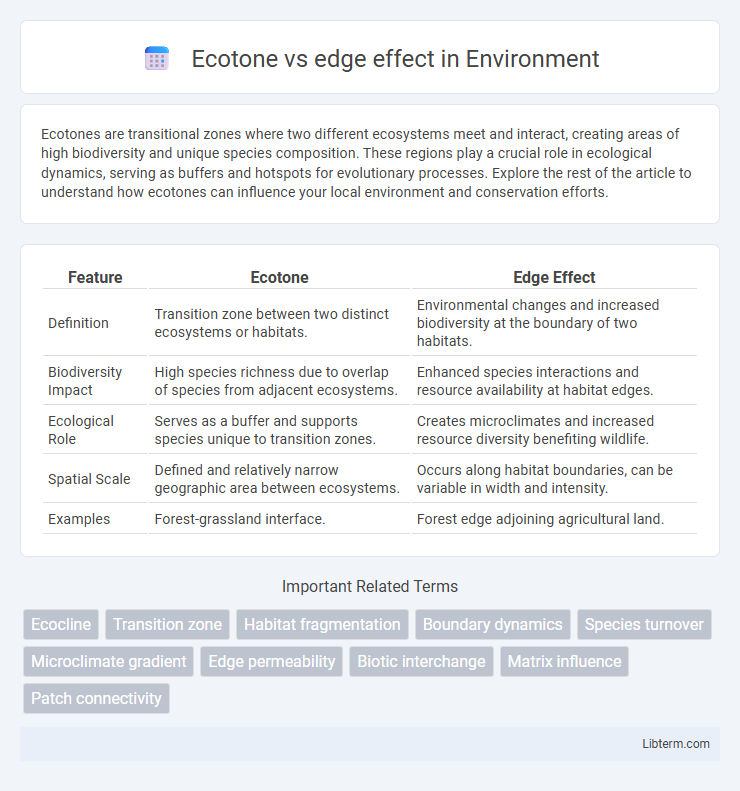Ecotones are transitional zones where two different ecosystems meet and interact, creating areas of high biodiversity and unique species composition. These regions play a crucial role in ecological dynamics, serving as buffers and hotspots for evolutionary processes. Explore the rest of the article to understand how ecotones can influence your local environment and conservation efforts.
Table of Comparison
| Feature | Ecotone | Edge Effect |
|---|---|---|
| Definition | Transition zone between two distinct ecosystems or habitats. | Environmental changes and increased biodiversity at the boundary of two habitats. |
| Biodiversity Impact | High species richness due to overlap of species from adjacent ecosystems. | Enhanced species interactions and resource availability at habitat edges. |
| Ecological Role | Serves as a buffer and supports species unique to transition zones. | Creates microclimates and increased resource diversity benefiting wildlife. |
| Spatial Scale | Defined and relatively narrow geographic area between ecosystems. | Occurs along habitat boundaries, can be variable in width and intensity. |
| Examples | Forest-grassland interface. | Forest edge adjoining agricultural land. |
Introduction to Ecotones and Edge Effect
Ecotones represent transitional zones where two or more distinct ecosystems or habitats converge, creating areas of increased biodiversity and unique species interactions. The edge effect refers to the changes in population or community structures that occur at these boundaries, often resulting in greater species richness but also increased vulnerability to environmental pressures. Understanding ecotones and the edge effect is crucial for conservation biology and ecosystem management due to their influence on habitat connectivity and species distribution.
Defining Ecotones: Nature’s Transitional Zones
Ecotones are natural transitional zones where two or more distinct ecosystems meet and integrate, creating areas of high biodiversity and unique environmental conditions. These zones exhibit characteristics of the adjacent ecosystems while also supporting specialized species adapted to the transitional environment. Unlike the edge effect, which refers to the increased species diversity and ecological interactions at the borders of habitats, ecotones represent a broader and more distinct ecological boundary with dynamic biological and physical gradients.
Understanding the Edge Effect in Ecology
The edge effect in ecology refers to changes in population or community structures that occur at the boundary of two or more habitats, creating unique environmental conditions that support increased biodiversity. Ecotones are specific transitional zones where different ecosystems meet, often exhibiting pronounced edge effects due to the mixing of species and resources from adjacent habitats. Understanding the edge effect is crucial for habitat conservation, as these areas can harbor distinct species assemblages and influence ecological processes such as species migration and nutrient cycling.
Key Differences Between Ecotones and Edge Effects
Ecotones represent transitional zones between two distinct ecosystems characterized by a unique assemblage of species and increased biodiversity, while edge effects refer to the environmental changes and impacts experienced at the boundary of two habitats. Ecotones often exhibit higher species richness due to the overlap of species from adjacent ecosystems, whereas edge effects can cause habitat fragmentation, influencing species behavior and microclimate conditions. Key differences include that ecotones are naturally occurring transition areas with ecological significance, whereas edge effects typically result from human activities causing habitat boundaries and alterations.
Ecotone Characteristics and Ecological Roles
Ecotones exhibit increased biodiversity and species richness due to the overlapping presence of organisms from adjacent ecosystems, creating unique habitats with hybrid environmental conditions. These transitional zones often possess heightened productivity, microclimate variability, and resource availability, fostering specialized species adapted to edge environments. Ecotones play critical ecological roles by serving as buffers that regulate ecosystem processes, corridors for wildlife movement, and hotspots for genetic exchange and species interactions.
How Edge Effects Influence Biodiversity
Edge effects significantly influence biodiversity by creating unique environmental conditions where two ecosystems meet, known as ecotones. These transitional zones often support greater species richness due to the overlap of habitat types, increased resource availability, and microclimatic variations. However, edge effects can also lead to habitat fragmentation, invasive species invasion, and altered predator-prey dynamics, which may negatively impact sensitive species and overall ecosystem stability.
Factors Affecting Ecotone Formation
Ecotone formation is influenced by factors such as environmental gradients, species interactions, and disturbance regimes, which regulate the transition between adjacent ecosystems. Abiotic variables including soil type, moisture levels, and microclimate conditions shape the spatial extent and species composition within ecotones. Biotic factors, such as competition, mutualism, and migration patterns, further determine the stability and biodiversity found in these boundary zones, differentiating them from general edge effects.
Impact of Edge Effects on Species Distribution
Edge effects significantly influence species distribution by altering habitat conditions at ecotones, the transitional zones between distinct ecosystems. These changes create microclimates and resource availability gradients that favor edge-adapted species while often reducing biodiversity of interior specialists. Ecotones, therefore, act as dynamic boundaries where species composition shifts in response to varying environmental pressures caused by habitat fragmentation and human activities.
Human Activities and Their Influence on Ecotones and Edges
Human activities such as urban development, agriculture, and deforestation significantly alter ecotones and edge environments, often intensifying the edge effect by creating fragmented habitats. These anthropogenic changes can increase species invasions, disrupt native biodiversity, and modify microclimates within ecotones, impacting ecological processes and ecosystem services. The influence of human-induced fragmentation highlights the critical role of landscape management in mitigating adverse effects on ecotones and maintaining ecological integrity.
Conservation Implications of Ecotone and Edge Effect
Ecotones and edge effects both influence biodiversity but differ in spatial scale and species interactions, impacting conservation strategies. Ecotones, as transition zones between distinct ecosystems, often support higher species richness and unique communities essential for maintaining genetic diversity and ecosystem resilience. Edge effects, typically resulting from habitat fragmentation, can lead to microclimatic changes and increased vulnerability to invasive species, necessitating careful management to mitigate habitat degradation and promote buffer zones in conservation planning.
Ecotone Infographic

 libterm.com
libterm.com